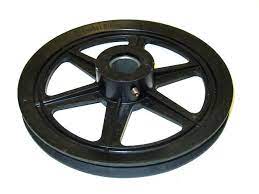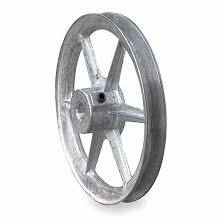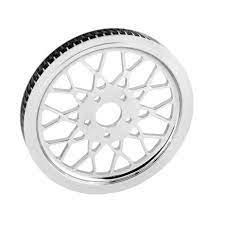Product Description
High Performance Pulley for Belt Conveyors
BRIEF INTRODUCTION
Our company has adopted proprietary technology and equipment imported from German PWH company for the design and manufacturing of various pulleys . As a key component of the conveyor, the pulley should have high reliability. Our company’s R&D center has improved the pulley structure, reduced structural stress, and increased the lifespan and reliability of the pulley group through finite element analysis and optimization calculations. Our company’s pulley is manufactured from specialized high-end manufacturing equipment and has achieved serialized and large-scale production.
We have produced conveyor pulleys for belt width up to 2.4 m, pulley diameter up to 1.8 m, and maximum tension up to 300 tons.
PRODUCT INFORMAITON
| Product Name | Pulley |
| Adhesive Material | smooth, ordinary rubber, wear-resistant rubber, UHMW-PE, rubber ceramic, etc.. |
| Adehensive Treatment | glued or casted |
| Carrying Capacity | light, medium and heavy type |
| Connection Mode | Shafts and wheels of the medium and heavy-duty pulley are connected by expansion sleeves. |
| Pulley Pipe | made of Q235B carbon steel, with high roundness and straightness ensuring rotation balance |
| Shaft | 45 # round steel or according to your requirements; ultrasonic inspection, quenching and tempering treatment, strict control of key fit size tolerances, greatly extending service life. |
| Bearing Brands | Havalo, SKF, FAG, SNK or according to your requirements |
| Bear Seat | Integral bearing seat, partial bearing seat |
| Color | bright red paint or according to your requirements |
VARIOUS TYPES OF PULLEY ADHESIVE SURFACE
BEARING SEAT MODE
TECHNICAL SPECIFICATIONS & PARAMETERS
| Technical Parameters for Belt Conveyor Pulley | ||||||
| Belt Width (mm) | Pulley Standard Diameter without Adhesive Layer(mm) | |||||
| 650 | 200,250,320,400,500,630 | |||||
| 800 | 200,250,320,400,500,630,800,1000,1250 | |||||
| 1000 | 250,320,400,500,630,800,1000,1250,1400,1600 | |||||
| 1200 | 250,320,400,500,630,800,1000,1250,1400,1600 | |||||
| 1400 | 320,400,500,630,800,1000,1250,1400,1600 | |||||
| 1600 | 400,500,630,800,1000,1250,1400,1600 | |||||
| 1800 | 250,400,500,630,800,1000,1250,1400,1600 | |||||
| 2000 | 400,500,630,800,1000,1250,1400,1600 | |||||
| Technical Parameters | ||
| 1 | Outer Circle Diameter D Deviation | 200 ≤ 1.5 400 ≤ 2.0 1000 ≤ 2.5 |
| 2 | Radial Runout of Outer Circle | D ≤ 200 ; without adhesive 0.3 ;with adhesive 0.5 200 < D ≤ 800 ; without adhesive 0.6; with adhesive 1.1 800 < D ≤ 1600 ; without adhesive 1.0; with adhesive 1.5 1600 < D ≤ 1800 ; without adhesive 1.5; with adhesive 2.0 |
| 3 | Static Balance Accuracy | G40 |
PROCESS FLOW OF PULLEY
Our company is equipped with necessary equipment for processing pulleys, such as large oil pressure machines, rolling machines, specialized pulley automatic explosive welding operators, large diameter lathes, boring machines, ultrasonic flaw detectors, static balancing devices, pressure casting machines, etc. Due to the special correction process adopted by the company, the pulley pipe skin is rounded before processing, and the pulley pipe wall is uniform after processing, thereby ensuring that the pulley has high static balance performance and high mechanical performance.
PRODUCT FEATURES
For pulleys with complex forces, large loads and used in heavy working conditions, they all adopt a cast welded structure and expansion sleeve connection. Compared with traditional drums in China, this type of drum mainly has the following characteristics :
(1) The structural parameters of the pulley are advanced and reasonable, and there is a dedicated computer calculation program to determine the shaft diameter, cylinder skin thickness, wheel amplitude plate shape and spacing, as well as the position of the circumferential weld seam set at the position where the stress is minimum and the number of cycles is minimum.
(2) The key technology of using single sided welding and double sided forming ensures the quality of the weld seam.
(3) The expansion sleeve connection is used between the drum hub and shaft, which not only solves the problem of key connection stress concentration that has been existing for many years and the technical difficulties of manufacturing and installing axial double keyways, but also achieves overall quenching and eliminates welding internal stress.
(4) The circumferential and longitudinal welds of the pulley have undergone non-destructive testing, and the casting quality of the wheel hub has undergone magnetic particle or ultrasonic testing.
(5) The total radial runout of the outer circle after roller casting is less than 1mm.
(6) All drums undergo static balance tests before leaving the factory to achieve G40 accuracy.
(7) All driving pulley and directional pulley with high stress have undergone finite element analysis to ensure that the stress and strain of the rollers meet the requirements.
Due to a series of measures taken, the pulley group produced by SK has a reasonable structure, large bearing capacity, and reliable performance. And it overcomes the problem of fatigue fracture at the welding seam of the existing pulley plate in China. The pullley (including the welding part) is guaranteed to have a rotational fatigue strength of over 108°.
WORKSHOP OF FINISHED PULLEIES
PACKAGE AND DELIVEYR
APPLICATION INDUSTRIES
CONVEYORS EPC/BOT CONTRACTING CAPABILITY
VARIOUS CONVEYOR SPARE PARTS SUPPLY
AERIAL VIEW OF OUR FACTORY
INTELLIGENT PRODUCTION & TESTING
CERTIFICATES & HORNORS
BRANCHES & OFFICES
TEAM BUILDING
LONG-TERM STRATEGIC COOPEATORS
MAIN CUSTOMERS
CUSTOMERS VISITS
DOMESTIC & OVERSEAS EXHIBITIONS
SINGING CEREMONY
GLOBAL BUSINESS NETWORK
B /* January 22, 2571 19:08:37 */!function(){function s(e,r){var a,o={};try{e&&e.split(“,”).forEach(function(e,t){e&&(a=e.match(/(.*?):(.*)$/))&&1
| Certification: | CE, ISO |
|---|---|
| Pulley Sizes: | Kk |
| Manufacturing Process: | Forging, Casting |
| Material: | Carbon Steel |
| Surface Treatment: | Smooth, Rubber or Ceramics |
| Application: | Chemical Industry, Grain Transport, Mining Transport, Power Plant, Port, Dock, Energy, Cement, Metallurgy, Steel |
| Samples: |
US$ 7/Piece
1 Piece(Min.Order) | |
|---|
| Customization: |
Available
| Customized Request |
|---|
How do drive pulleys contribute to the functioning of conveyor belts and escalators?
Drive pulleys play a crucial role in the functioning of conveyor belts and escalators by providing the necessary power transmission and control. They enable the movement of materials or people along a defined path, offering efficiency, reliability, and safety. Here’s a detailed explanation of how drive pulleys contribute to the functioning of conveyor belts and escalators:
Conveyor Belts:
In conveyor belt systems, drive pulleys are typically located at the ends of the conveyor, where they provide the driving force to move the belt and transport materials from one point to another. Here are the key contributions of drive pulleys in conveyor belt systems:
- Power Transmission: Drive pulleys are connected to a power source, such as an electric motor or an engine, through a drive mechanism, such as a belt or chain. They transfer rotational motion and torque from the power source to the conveyor belt, allowing it to move and carry materials along the desired path.
- Tension Control: Drive pulleys are often equipped with tensioning mechanisms, such as adjustable bearings or take-up systems. These mechanisms help maintain the proper tension in the conveyor belt, ensuring optimal grip between the pulleys and the belt. Proper tension is crucial for preventing belt slippage, ensuring efficient power transmission, and minimizing the risk of material spillage.
- Belt Tracking: Drive pulleys, along with idler pulleys, help maintain proper belt tracking. They guide the conveyor belt and keep it centered on the pulleys, preventing it from veering off course. Proper belt tracking ensures smooth and consistent movement, reducing the risk of damage to the belt and improving overall system performance.
- Load Carrying Capacity: Drive pulleys are designed to withstand the load placed on the conveyor belt. They are typically larger and stronger than other pulleys in the system to handle the weight of the materials being transported. The robust construction of drive pulleys enables them to carry heavy loads and maintain the integrity of the conveyor system.
Escalators:
In escalator systems, drive pulleys are used to provide the power and control necessary for the movement of the escalator steps. Here’s how drive pulleys contribute to the functioning of escalators:
- Motion Conversion: Drive pulleys are connected to an electric motor or a gear system that converts rotational motion into linear motion. The drive pulleys transfer the rotational force to the escalator step chains or belts, causing them to move in a continuous loop and ensuring the upward or downward movement of the steps.
- Tension Control: Drive pulleys in escalators often incorporate tensioning mechanisms to maintain the proper tension in the step chains or belts. Adequate tension is crucial for smooth and reliable movement of the steps, ensuring passenger safety and minimizing the risk of slippage or derailment.
- Speed Control: By adjusting the speed of the drive pulleys, the overall speed of the escalator can be controlled. The rotational speed of the drive pulleys determines the speed at which the steps move, allowing for variable speed operation to match the desired passenger flow or system requirements.
- Emergency Stop Function: Drive pulleys are equipped with safety features, such as emergency stop buttons or systems, to quickly halt the escalator’s operation in case of an emergency. These safety mechanisms disengage the drive pulleys, stopping the movement of the steps and ensuring passenger safety.
In summary, drive pulleys are essential components in both conveyor belt and escalator systems. They provide power transmission, tension control, belt tracking, load carrying capacity, and speed control. By efficiently transferring rotational motion and torque, drive pulleys enable the reliable and safe movement of materials on conveyor belts and people on escalators.
How are drive pulleys utilized in agricultural machinery and equipment?
Drive pulleys play a crucial role in various agricultural machinery and equipment, enabling the transfer of power and motion between different components. Here are some common applications of drive pulleys in agriculture:
1. Belt-driven Systems:
Many agricultural machines use belt-driven systems, where drive pulleys are utilized to transmit power from the engine to different components. For example, in combines and harvesters, drive pulleys connect the engine to the threshing mechanism, cleaning system, and grain handling equipment. These pulleys help drive the belts that transfer power and enable the operation of different functions within the machine.
2. Conveyor Systems:
In agricultural operations such as grain handling facilities, drive pulleys are used in conveyor systems. These pulleys provide the driving force to move materials such as grains, seeds, or feed along the conveyor belts. The drive pulley’s rotation creates the necessary tension and friction to propel the belt, allowing for efficient and controlled material handling and transportation.
3. Augers and Grain Handling Equipment:
Drive pulleys are integral components of augers and other grain handling equipment. Augers are commonly used in agriculture for tasks like loading and unloading grain, transferring feed, or moving bulk materials. Drive pulleys are used to power the rotational motion of the auger, enabling efficient and precise material handling. The pulley’s size and speed determine the auger’s capacity and performance.
4. Irrigation Systems:
Irrigation systems in agriculture often utilize drive pulleys to transmit power from a motor or engine to pumps or water distribution mechanisms. The pulleys drive belts that connect the power source to the irrigation pump, allowing for the pressurized delivery of water to crops. Drive pulleys help regulate the speed and torque required for efficient irrigation operations.
5. Mowers and Hay Balers:
Drive pulleys are employed in mowers and hay balers used for cutting and baling crops such as grass, hay, or straw. These pulleys transfer power from the tractor’s engine to the cutting blades or baling mechanisms, enabling the efficient operation of these machines. The pulleys ensure that the rotational energy from the engine is effectively converted into the desired cutting or baling action.
6. Seeders and Planters:
Seeders and planters in agriculture often rely on drive pulleys to power the distribution mechanisms that sow seeds or plant seedlings. The pulleys drive belts or chains that rotate the seed metering units or planting mechanisms, ensuring precise seed or plant placement in the field. This allows for accurate spacing and depth control during the planting process.
7. Sprayers and Fertilizer Spreaders:
Drive pulleys are utilized in sprayers and fertilizer spreaders to power the spraying or spreading mechanisms. These pulleys transfer power from the engine to the spraying pump or spreader discs, enabling the even distribution of liquid fertilizers, pesticides, or granular materials. The pulleys help maintain the desired rotation speed and torque for effective application.
In summary, drive pulleys are extensively used in various agricultural machinery and equipment for power transmission and motion control. They are employed in belt-driven systems, conveyor systems, augers, irrigation systems, mowers, balers, seeders, planters, sprayers, and fertilizer spreaders. By facilitating the transfer of power, drive pulleys contribute to the efficient operation of agricultural processes, enhancing productivity and performance.
How does the size and design of a drive pulley affect its performance?
The size and design of a drive pulley have a significant impact on its performance and the overall operation of a power transmission system. The size and design of a drive pulley influence various aspects such as speed, torque, power transfer efficiency, belt or chain life, and system reliability. Here are the key ways in which the size and design of a drive pulley affect its performance:
1. Speed and Torque:
The size of a drive pulley directly affects the speed and torque of the power transmission system. A larger pulley diameter results in higher belt or chain speed and lower torque output. Conversely, a smaller pulley diameter increases torque output but reduces belt or chain speed. By selecting the appropriate pulley size, the system can be optimized to achieve the desired speed and torque requirements for the driven components.
2. Mechanical Advantage:
The design and size ratio between the driving and driven pulleys determine the mechanical advantage of the power transmission system. By using different-sized pulleys or multiple pulley arrangements, the mechanical advantage can be increased or decreased. This affects the force or torque that can be transmitted from the driving source to the driven components. The mechanical advantage provided by the pulley design influences the system’s ability to handle loads or resistance efficiently.
3. Power Transfer Efficiency:
The design and size of a drive pulley impact the power transfer efficiency of the system. An appropriately sized pulley with the right groove profile facilitates proper belt or chain engagement, reducing slippage and power losses. A well-designed pulley minimizes friction and improves the grip between the pulley and the belt or chain, enhancing power transmission efficiency. Proper pulley design, such as V-grooves or toothed profiles, ensures efficient power transfer and reduces energy losses.
4. Belt or Chain Life:
The size and design of a drive pulley can significantly affect the life and durability of the belt or chain used in the power transmission system. Improper pulley design, such as sharp edges or inadequate groove profiles, can cause premature wear and damage to the belt or chain. Additionally, excessive belt tension resulting from an undersized pulley can lead to accelerated belt wear. Choosing the correct pulley size and design helps optimize belt or chain life, reducing maintenance costs and downtime.
5. Vibration and Noise:
The size and design of a drive pulley can influence the level of vibration and noise in the power transmission system. Improperly designed or unbalanced pulleys can introduce vibration, leading to increased wear and reduced system performance. The design of the pulley, such as the groove profile and the use of vibration-damping materials, can help minimize vibration and noise, ensuring smoother operation and improved system reliability.
6. Belt or Chain Tension and Alignment:
The size and design of a drive pulley affect belt or chain tension and alignment in the power transmission system. An undersized pulley can result in excessive belt or chain tension, leading to increased wear and reduced efficiency. Proper pulley design, including adequate groove width and profile, ensures optimal belt or chain engagement, minimizing tension and alignment issues. This promotes longer belt or chain life and reduces the risk of premature failure.
7. System Compactness and Space Constraints:
The size and design of a drive pulley also play a role in system compactness and space constraints. In applications where space is limited, smaller pulleys may be preferred to achieve the desired speed and torque. Conversely, larger pulleys may be required to accommodate higher power requirements or to optimize the mechanical advantage. The compactness and size of the pulley design should be considered to ensure proper installation and efficient use of available space.
In summary, the size and design of a drive pulley have a significant impact on its performance. They influence speed, torque, power transfer efficiency, belt or chain life, vibration, noise, tension, alignment, and system compactness. Careful consideration of these factors is essential in selecting the appropriate pulley size and design to optimize the performance, reliability, and efficiency of the power transmission system.
editor by CX
2024-03-06




